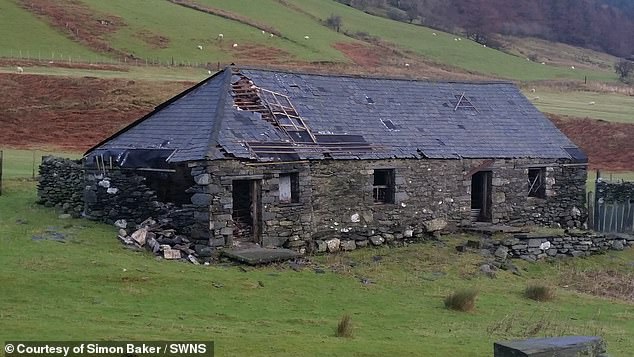I put all my savings into purchasing a cowshed to turn it into my dream home

A man put his savings into purchasing a crumbling cowshed and turned it into a dream home.
Simon Baker, 52, sold his one-bed flat in London to buy an abandoned Eryri cowshed in North Wales’ Machno Valley.
Simon poured all his savings into buying the land and acknowledged it was a ‘huge gamble’ as there was no planning permission for the shed.
But he has no regrets about having to spend cold nights camping in the back of his Ford Focus while the old stone building was renovated.
And the now modern-looking barn – believed to date from 1760 – has become a finalist in the BBC One show Wales Home of The Year.
Simon said: ‘When I saw the shed I fell in love with it; it was a heart-over-head decision. Everyone in my family thought I was crazy.
‘I have always had the urge to do a construction and restoration project. And I saw that this property had been put up for auction in 2013.
‘It was for sale without any planning permission to convert it. I saw it online and thought it looked like a project that could be good.

A man put his savings into buying a crumbling cowshed (pictured) and turned it into a dream home

Simon Baker, 52, (pictured) sold his one-bed flat in London to buy an abandoned Eryri cowshed in North Wales’ Machno Valley

The building was an abandoned, crumbling cowshed, never lived in, with no access or amenities
‘With the right support and a bit of luck I could do it. I bought it before the auction and then part of it fell off, which was a bit worrying.”
The renovation prospects did not look promising as the barn had no planning permission and was subject to a restrictive covenant from the National Trust – which required their consent.
And the building was an abandoned, crumbling cowshed, never lived in, with no access or amenities.
But after carefully preserving the surviving elements of the old cowshed, Simon applied clever interior design tricks – and Welsh roof slates sourced from the Cwt-y-Bugail quarry, just two miles from the barn.
He also worked with a number of people on site to understand how best to restore it.
‘There was no point in loving the place and then completely changing it. I wanted to keep bricks visible in every direction you look in the shed,” Simon said.
“I had a fantastic local builder who I convinced to join me on this journey. They have worked in these types of buildings all their lives, because they do so faithfully to tradition.
‘It was quite a challenge to fit everything in and I realize that the best way to use the space is with a curved staircase. And once I realized that was the best way to do it, everything else had to be turned around.”

‘There was no point in loving the place and then completely changing it. I wanted to keep bricks visible in every direction you look in the shed,” Simon said

“I had a fantastic local builder who I convinced to come with me on this journey – they have worked in these types of buildings all their lives, because they usually do it true to tradition,” he said

Simon said: ‘It completely suits my way of life and that is extremely satisfying’

His renovation made it to the final of the BBC Wales Home of the Year awards

His new home is in the Makhno Valley in North Wales

He processed slate from a quarry just two miles from his home
He explained that while he was a little apprehensive about the construction task, it was a “hugely rewarding process” of living in a space he designed himself.
Simon said: ‘It completely suits my way of life and that is extremely satisfying.
‘The land was affordable by today’s standards. I took a huge gamble buying the land because I had to put all my savings into buying the land from the start.
‘And it was a big risk because there was no permission for it.
‘When I bought this I was living in a flat in south London – it was a big change. It was a big step to start the project, which came with its own challenges.
‘I was a little scared. Building it is quite interesting because you start with control in the beginning and somewhere in the middle you lose control and you have to finish or you might lose everything and have to keep going.”
Where possible, the old beams of the barn have been retained. And from the outside, the barn looks much as it did in the 18th century.
He added: ‘I’ve done a lot of renovations and I’ve always been interested in the design of the building. I owe a lot of this work to my father, who loved DIY – my father was probably my inspiration for this.’

‘I was a little scared. Building it is very interesting because in the beginning you start with control and then somewhere in the middle you lose control and you have to finish or you might lose everything and you have to keep going,” said Simon

The National Trust told Simon that the cowshed dated from 1790

It was abandoned because it was ‘too small for modern agricultural needs’

Simon works at Network Rail as an incident manager

‘It’s my forever home. I enjoyed living in London and I still have to go there every now and then. “I’ve always enjoyed having a contrast in my life,” he added

He said he couldn’t have built the house without the support of the local community
As a way of thanking those involved in the barn renovation, Simon decided to apply for BBC One’s Wales Home of The Year award.
And made it to the final that will be broadcast in December.
He said: ‘I’m not interested in publicity for me. I wanted to put the spotlight on the locals here who have worked so hard for it.
‘The great thing about doing a self-build project is that you feel like you are part of the community.
‘You buy all the materials from the local population and many of the people who worked on it are very good friends. The builders graze some sheep in my top field.
‘It’s my forever home. I enjoyed living in London and I still have to go there every now and then. I’ve always enjoyed having a contrast in my life.’
Simon, who works as an incident manager for Network Rail, says he is even currently learning Welsh to become part of the community as it is their first language.
He added: “People in the village remember milking the cows when it was a cowshed. The National Trust told me it dates from 1760. It is quite old, but the reason it is abandoned is that it is too small for modern agricultural needs.
“I can look around the valley here and they are in various stages of disrepair. Once the roof falls down due to the strong wind and pieces of stone are reused, they simply disappear.
“I felt like I could be a lifesaver for this small, simple barn and preserve it for future generations.”




